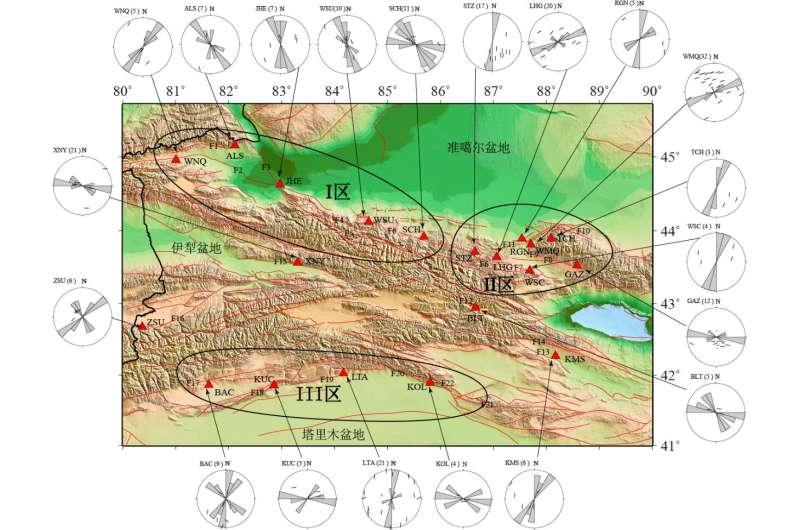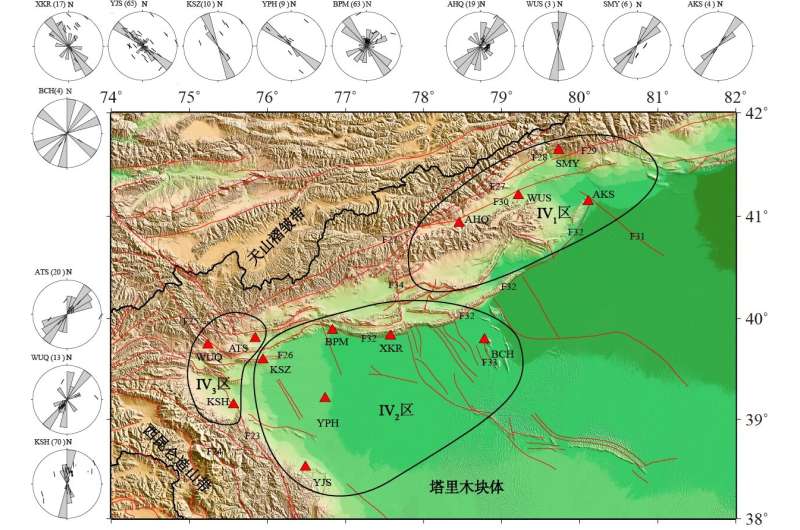Distribution of fast-wave polarization directions in the middle part of the Tianshan Mountains. Credit: Science China Press
The collision between the Indian and Eurasian plates resulted in the formation of the Tianshan Tectonic Belt; however, the formation mechanism of Tianshan and the construction of a dynamic model explaining it remain to be realized and an integrated understanding has not been reached. A new study adopted shear-wave splitting system to collect and analyze shear-wave splitting parameters of 33 stations in the Tianshan area, it provides new evidence for potentially enhance the understanding the dynamic mechanism of the Tianshan tectonic belt.
The research paper is titled, "Anisotropic zoning in the upper crust of the Tianshan Tectonic Belt," Published in Science China Earth Sciences Issue 4, 2021, Corresponding author of the paper is Yuan Gao, Institute of Earthquake Prediction, China Earthquake Administration. Li Jin, works in the Earthquake Administration of Xinjiang Uygur Autonomous Region, is the first author. This study investigates the spatial distribution of seismic anisotropy in the upper crust at 33 stations measured during 2009-2019 in the Tianshan Tectonic Belt.
Current research on the anisotropy of Tianshan is insufficient due to the lack of observational data, the research found that the polarization directions of fast waves at various stations in the Tianshan Tectonic Belt show obvious zoning in terms of spatial distribution. In the area with the strong surface piedmont deformation in the Tianshan Tectonic Belt, the polarization directions are consistent with the tectonic stress field. The obvious stress extrusion observations could be related to dynamic models such as interlayer insertion and reduction and intraplate subduction. The Tianshan Orogenic Belt is relatively softer compared to the basins located on both sides of the north and the south. As the main crustal shortening area, the Tarim Basin thrusts and subducts beneath the Tianshan into the crust and the upper mantle, due to the long-range influences of the convergence between the Indian Plate and Siberian Plate.
Shear-wave polarization directions in the western segment of the South Tianshan Mountain Range. Credit: Science China Press
Time delays of slow waves exhibit spatial differences. The time delays in the Tianshan Tectonic Belt, regardless of North Tianshan or South Tianshan, increase from east to west. These results are consistent with the north-south convergence deformations across the Tianshan Mountains, where the deformation rate increased from east to west. The average values of time delays in northeastern Pamir are significantly higher than that in the other areas due to the occurrence of the most intensive tectonic movements suggesting that the anisotropy of the zone is significantly stronger than that of the other zones in the Tianshan Tectonic Belt.
This research successfully deciphered the seismic anisotropy in the upper crust and provided a comprehensive and systematic understanding of the dynamic mechanisms of the Tianshan Tectonic Belt.
More information: Jin Li et al, Anisotropic zoning in the upper crust of the Tianshan Tectonic Belt, Science China Earth Sciences (2021). DOI: 10.1007/s11430-020-9709-0
Journal information: Science China Earth Sciences
Provided by Science China Press
























